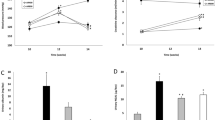Abstract
Chlorella vulgaris is a unicellular green alga resistant to heavy metals. Chlorella is a rich nutritional ingredient because it contains high levels of antioxidants. The objective of this research was to study if C. vulgaris protect renal cells against mercury-chloride-caused oxidative stress and cellular damage in the kidney. Our results demonstrated that HgCl2 causes oxidative stress and cellular damage, and that C. vulgaris administration prevents oxidative stress and cellular damage in kidney




Similar content being viewed by others
References
Cano-Europa E, Lopez-Galindo GE, Hernandez-Garcia A, Blas-Valdivia V, Gallardo-Casas CA, Vargas-Lascari M, Ortiz-Butron R (2008) Lidocaine affects the redox environment and the antioxidant enzymatic system causing oxidative stress in the hippocampus and amygdala of adult rats. Life Sci 83:681–685
Cano-Europa E, Ortiz-Butron R, Blas-Valdivia V, Pineda-Reynoso M, Olvera-Ramírez R, Franco-Colín M (2009) Phycobiliproteins from Pseudanabaena tenuis rich in c-phycoerythrin protect against HgCl2-caused oxidative stress and cellular damage in the kidney. J Appl Phycol. doi:10.1007/s10811-009-9484-z
Chavez E, Holguin JA (1988) Mitochondrial calcium release as induced by Hg2+. J Biol Chem 263:3582–3587
Fouda AM, Daba MH, Dahab GM, Sharaf El-Din OA (2008) Thymoquinone ameliorates renal oxidative damage and proliferative response induced by mercuric chloride in rats. Basic Clin Pharmacol Toxicol 103:109–118
Friberg L, Odeblad E, Forssman S (1957) Distribution of two mercury compounds in rabbits after a single subcutaneous injection; a radiometric and autoradiographic study of the distribution of mercuric chloride and phenylmercuric acetate. AMA Arch Ind Health 16:163–168
Halliwell B, Gutteridge JMC (2007) Free radicals in biology and medicine. Oxford University Press, UK
Ibusuki K, Minamishima Y (1990) Effect of Chlorella vulgaris extracts on murine cytomegalovirus infections. Nat Immun Cell Growth Regul 9:121–128
Kerem M, Salman B, Pasaoglu H, Bedirli A, Alper M, Katircioglu H, Atici T, Percin EF, Ofluoglu E (2008) Effects of microalgae Chlorella species crude extracts on intestinal adaptation in experimental short bowel syndrome. World J Gastroenterol 14:4512–4517
Kim YJ, Kwon S, Kim MK (2009) Effect of Chlorella vulgaris intake on cadmiun detoxification in rats fed cadmium. Nutrition Research and Practice 3:89–94
Lund BO, Miller DM, Woods JS (1993) Studies on Hg(II)-induced H2O2 formation and oxidative stress in vivo and in vitro in rat kidney mitochondria. Biochem Pharmacol 45:2017–2024
Mahboob M, Shireen KF, Atkinson A, Khan AT (2001) Lipid peroxidation and antioxidant enzyme activity in different organs of mice exposed to low level of mercury. J Environ Sci Health B 36:687–697
Merchant RE, Andre CA (2001) A review of recent clinical trials of the nutritional supplement Chlorella pyrenoidosa in the treatment of fibromyalgia, hypertension, and ulcerative colitis. Altern Ther Health Med 7:79–91
Miranda MS, Sato S, Mancini-Filho J (2001) Antioxidant activity of the microalga Chlorella vulgaris cultured on special conditions. Boll Chim Farm 140:165–168
Morita K, Matsueda T, Iida T, Hasegawa T (1999) Chlorella accelerates dioxin excretion in rats. J Nutr 129:1731–1736
Pawlik-Skowronska B, Pirszel J, Brown MT (2007) Concentrations of phytochelatins and glutathione found in natural assemblages of seaweeds depend on species and metal concentrations of the habitat. Aquat Toxicol 83:190–199
Peng HY, Chu YC, Chen SJ, Chou ST (2009) Hepatoprotection of Chlorella against carbon tetrachloride-induced oxidative damage in rats. In Vivo 23:747–754
Queiroz ML, Rodrigues AP, Bincoletto C, Figueiredo CA, Malacrida S (2003) Protective effects of Chlorella vulgaris in lead-exposed mice infected with listeria monocytogenes. Int Immunopharmacol 3:889–900
Rodríguez-García I, Guil-Guerrero JL (2008) Evaluation of the antioxidant activity of three microalgal species for use as dietary supplements and in the preservation food. Food Chem 108:1023–1026
Schafer FQ, Buettner GR (2001) Redox environment of the cell as viewed through the redox state of the glutathione disulfide/glutathione couple. Free Radic Biol Med 30:1191–1212
Sener G, Sehirli O, Tozan A, Velioglu-Ovunc A, Gedik N, Omurtag GZ (2007) Ginkgo biloba extract protects against mercury(II)-induced oxidative tissue damage in rats. Food Chem Toxicol 45:543–550
Sharma MK, Sharma A, Kumar A, Kumar M (2007) Evaluation of protective efficacy of Spirulina fusiformis against mercury induced nephrotoxicity in Swiss albino mice. Food Chem Toxicol 45:879–887
Stohs SJ, Bagchi D (1995) Oxidative mechanisms in the toxicity of metal ions. Free Radic Biol Med 18:321–336
Su L, Wang M, Yin ST, Wang HL, Chen L, Sun LG, Ruan DY (2008) The interaction of selenium and mercury in the accumulations and oxidative stress of rat tissues. Ecotoxicol Environ Saf 70:483–489
Valko M, Rhodes CJ, Moncol J, Izakovic M, Mazur M (2006) Free radicals, metals and antioxidants in oxidative stress-induced cancer. Chem Biol Interact 160:1–40
Valko M, Leibfritz D, Moncol J, Cronin MT, Mazur M, Telser J (2007) Free radicals and antioxidants in normal physiological functions and human disease. Int J Biochem Cell Biol 39:44–84
Van Acker SABE, Koymans LMC, Bast A (1993) Molecular pharmacology of vitamin E: structural aspects of antioxidant activity. Free Radic Biol Med 15:311–328
Vijayavel K, Anbuselvam C, Balasubramanian MP (2007) Antioxidant effect of the marine algae Chlorella vulgaris against naphthalene-induced oxidative stress in the albino rats. Mol Cell Biochem 303:39–44
World Health Organization (2008) Elemental mercury and inorganic mercury compunds: human health aspects. Concise International Chemical Assessment Document 50 Geneve.
Zalups RK (2000) Molecular interactions with mercury in the kidney. Pharmacol Rev 52:113–144
Zalups RK, Lash LH (1990) Effects of uninephrectomy and mercuric chloride on renal glutathione homeostasis. J Pharmacol Exp Ther 254:962–970
Acknowledgment
This study was partially supported by SIP-IPN 20080113 and 20090485. H-G, A. and R. O-B are fellows of EDI, COFAA and SNI; V.B-V and P-Y, M are fellows of CONACyT and PIFI-COFFA.
Author information
Authors and Affiliations
Corresponding author
Rights and permissions
About this article
Cite this article
Blas-Valdivia, V., Ortiz-Butrón, R., Pineda-Reynoso, M. et al. Chlorella vulgaris administration prevents HgCl2-caused oxidative stress and cellular damage in the kidney. J Appl Phycol 23, 53–58 (2011). https://doi.org/10.1007/s10811-010-9534-6
Received:
Revised:
Accepted:
Published:
Issue Date:
DOI: https://doi.org/10.1007/s10811-010-9534-6




